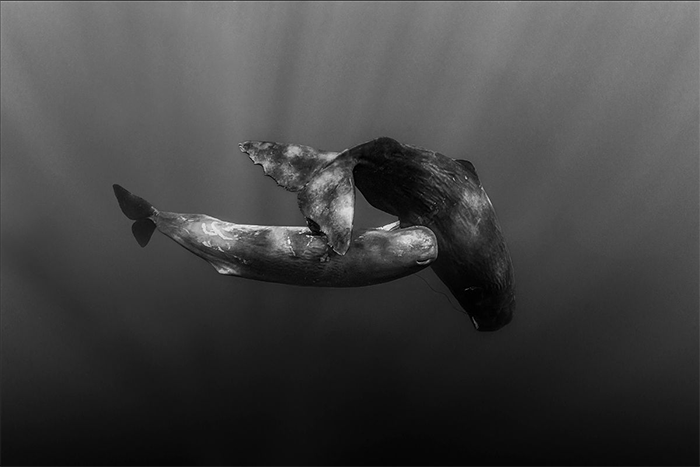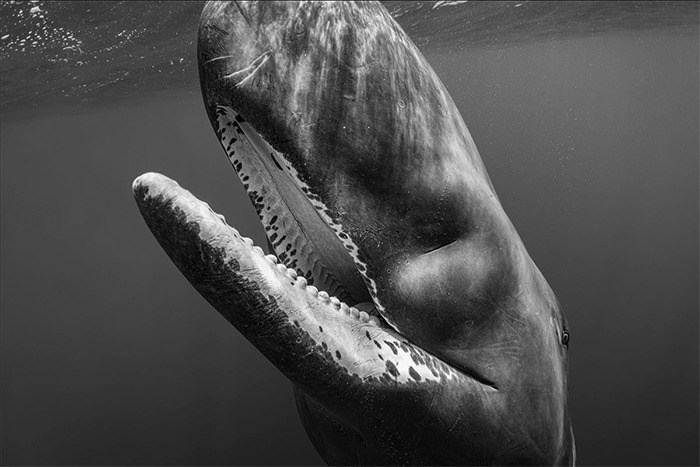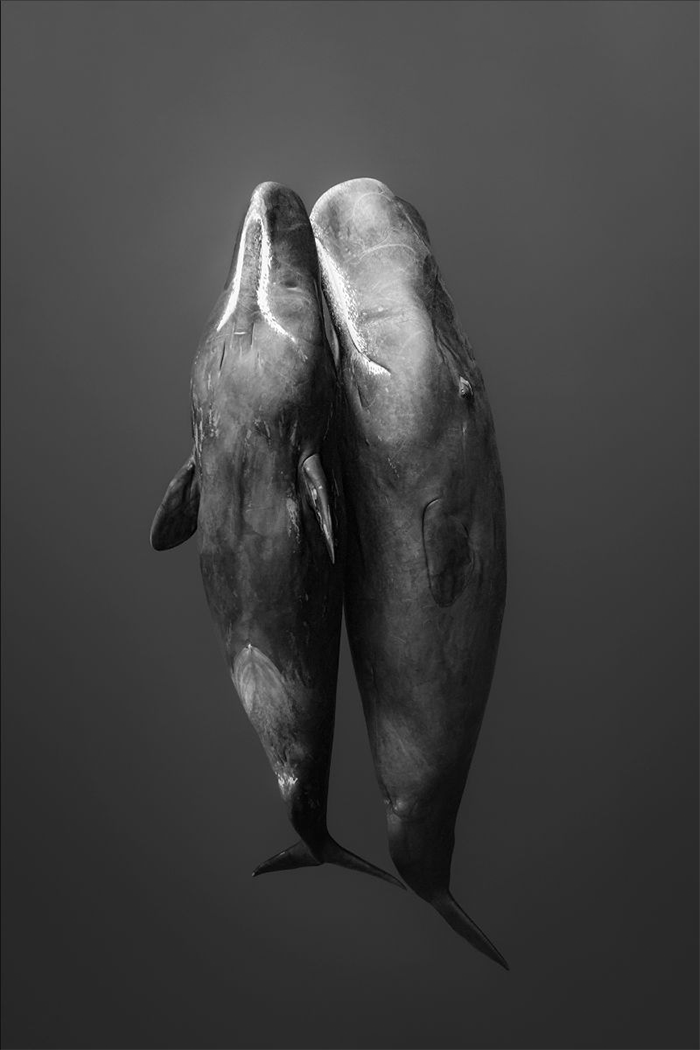Guest Post by Paul Nicklen | Sperm Whales: Matriarchs of the Deep
|
 |
Sperm whale calves like Ariel spend their earliest stages of life playing with their pod members, napping, and growing strong on mom’s milk and unconditional love.
If you have been following my work, you may already be familiar with the story of Ariel, the baby sperm whale. Ariel and I met a few years ago in the crystal clear waters of Dominica, and the two of us bonded after she decided I would make the perfect chew toy.Like most baby whales, Ariel was a mischievous youngster full of energy and curiosity for the world around her. She appeared deceptively well-behaved when I first slipped beneath the surface, clinging to her mother, named “Soursop” by local researchers, who was resting vertically in the water column. However, It did not take long for the calf to grow bored and after it became clear her mother was not interested in playing, she started to look elsewhere for entertainment. That was when her bright little eyes fell on Cristina and me floating quietly nearby.Before we knew it, we had a 15-ft baby whale barreling towards us. Cristina very wisely ducked out of the way while I braced for impact, preparing to be steamrolled. Instead, I found myself gently caught between Ariel’s gums before she playfully mouthed my camera dome. She then chased me around the surface while her mom continued to doze, taking full advantage of the free babysitting. The entire experience left me doubled over laughing and completely in love with these charismatic giants.

“Soursop,” a massive female matriarch and the mother of young Ariel, rests near the surface with a pair of tentacles wrapping around her head, the remnants of her latest meal. Sperm whales are expert divers capable of reaching over a mile deep in search of squid while using echolocation to sound out their way through the pitch-black depths.
Sperm whales are the largest toothed whales and the second-deepest divers of all cetaceans. You can find them predominantly in temperate and tropical regions across the entire ocean, following ancient waterways on their vast and mysterious migrations. They spend the majority of their lives hunting well over 3,000 ft deep in search of squid, their preferred prey and navigate the pitch black using echolocation to create a kind of map of their environment. They learn all of this at a young age from the patient teachings of their mothers and pod members, led under the guidance of the family matriarch.

We are, at the end of the day, fellow animals on this vast and strange planet. We are lucky to be here and share our world with our wild kin. The sooner we recognize our place within a living, ever-changing network, the sooner we can begin healing the damage we have done to our world.
Wherever whales, the largest living beings ever to have existed on Earth, are found, so are populations of some of the smallest living organisms, phytoplankton. Scientists have discovered that whales increase phytoplankton production wherever they go, in a never-ending cycle of life, through their waste. Whale waste contains minerals, gases, and nutrients that phytoplankton needs to grow. More phytoplankton means more carbon capture, and that’s key to combating climate change. If whales return to their pre-whaling number of 4 to 5 million — the worldwide population has crashed to little more than 1.3 million today — we would all be better for it.While adult male sperm whales tend to lead solo lives, females like Soursop and Ariel form pods to protect and raise young calves. For thousands of years, these matrilineal groups have traversed the deep oceans in the wake of the eldest and wisest female. Each matriarch carries the heavy responsibility of leading her pod to find food and mate during the breeding seasons. Throughout her over 70-year lifespan, she must successfully navigate along secret underwater routes while protecting her family against a constantly growing list of threats. Discarded fishing nets, boat strikes, plastic pollution, and the destructive effects of industrial fishing and deep-sea mining pose an ever-rising risk to whales and other marine wildlife.

A playful pair of sperm whales tangle in an underwater tango beneath the surface of Dominica’s Caribbean Sea. Unlike their mostly solitary male counterparts, female sperm whales form close-knit pods made up of mothers, aunts, and their young.
After spending time with Ariel and her incredibly patient and gentle mother, I have come to the realization that humans could stand to learn a thing or two from our ocean’s matriarchs. We, too, must navigate a rapidly warming and chaotic planet, contending with the consequences wrought by our own species. Perhaps if we learned to heed the voices of the wise women of the world, we would find ourselves on the path to a more empathetic and healthy future–one in which whales like Soursop and Ariel can safely raise their calves in a thriving ocean.
With immense gratitude and hope,

